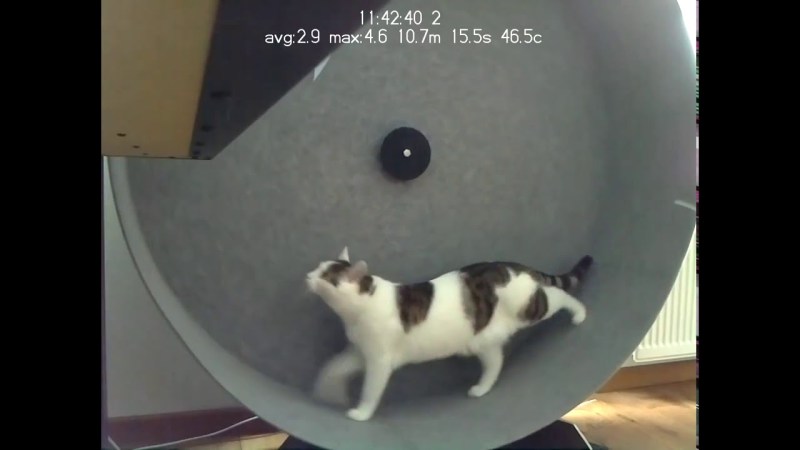We love furballs here at The MagPi, and this giant hamster-style wheel for exercising cats is a strong contender for our ‘pet project of the year’ award.
Jasper and Ruben are two cool cats, with an even cooler owner (who doesn’t want to be named). “[It’s] the same as a hamster wheel,” says Jasper’s owner. “They can run and walk on it whenever they please.” The proportions are a bit different: whereas most hamsters wheels are roughly twice the height of a hamster, this cat wheel is about three times a cat’s height.
The full article can be found in The MagPi 45 and was written by Lucy Hattersley
“The Raspberry Pi gets triggers from an electromagnetic sensor attached to the frame,” he tells us. There are “six small nails under the lining on the back of the wheel, serving as actuators. Based on these triggers, activity on the wheel can be detected, and the speed is calculated.”
The Raspberry Pi monitors the sensor using a GPIO port and on every trigger, the current speed is calculated. Jasper and Ruben were lured onto the wheel using cat treats. “We first let them get used to the wheel’s movement, as standing on it causes it to swing. Then we just held the treats a little higher so they’d have to start walking to get near them. We’d reward them when walking by actually giving them the cat treat and some additional attention, which is what it’s all about for them.”
Both cats are now used to the wheel, and they’ve been using it for a long time. “They both do,” says Jasper’s owner, “at least twice a day, any time, night or day. Preferably when somebody is admiring them.
They walk on it at about 3km/h and travel distances of over 250 metres,” he continues, “often taking several short breaks, which are mostly caused by distraction. Sometimes they take a sprint, usually peaking at 8km/h. Overall, they perform equally – if there’s a speed difference, it’s too small to notice.”
The build itself is also impressive. “The rear disc is a plywood plank, the cylinder is galvanised steel, and the surface of the entire wheel is covered in car lining. The entire frame is made of stainless steel, offering stability and necessary counterweight.
He tells us it was a relatively easy project. “The only problem was moving it because it’s large, bulky, and quite heavy. Having all the materials and necessary equipment in one place would have saved us a lot of time.
“I’d also like to be able to determine which cat is on the wheel,” he adds, “maybe by analysing the colours in the picture. That way I’ll be able to keep separate statistics.”
If you’re thinking of making a Catwheel, Jasper’s owner has some good advice: “Make it as big as possible, so that the cats can walk comfortably. Use a central bearing system and high-quality bearings, so the wheel runs smoothly and quietly. Cats don’t like noise, so a noisy wheel won’t be very tempting to them. When it’s finished and ready to use, be patient. Forcing a cat to do something will never work. Every cat is different, and it may just not be interested at all. It’s a risk you should be willing to take.”









